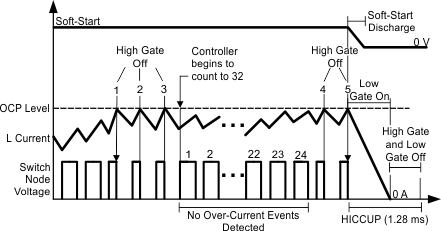ZHCS547K January 2010 – February 2018 LM27402
PRODUCTION DATA.
- 1 特性
- 2 应用
- 3 说明
- 4 修订历史记录
- 5 Pin Configuration and Functions
- 6 Specifications
-
7 Detailed Description
- 7.1 Overview
- 7.2 Functional Block Diagram
- 7.3
Feature Description
- 7.3.1 Wide Input Voltage Range
- 7.3.2 UVLO
- 7.3.3 Precision Enable
- 7.3.4 Soft-Start and Voltage Tracking
- 7.3.5 Output Voltage Setpoint and Accuracy
- 7.3.6 Voltage-Mode Control
- 7.3.7 Power Good
- 7.3.8 Inductor-DCR-Based Overcurrent Protection
- 7.3.9 Current Sensing
- 7.3.10 Power MOSFET Gate Drivers
- 7.3.11 Pre-Bias Start-up
- 7.4 Device Functional Modes
-
8 Application and Implementation
- 8.1
Application Information
- 8.1.1 Converter Design
- 8.1.2 Inductor Selection (L)
- 8.1.3 Output Capacitor Selection (COUT)
- 8.1.4 Input Capacitor Selection (CIN)
- 8.1.5 Using Precision Enable
- 8.1.6 Setting the Soft-Start Time
- 8.1.7 Tracking
- 8.1.8 Setting the Switching Frequency
- 8.1.9 Setting the Current Limit Threshold
- 8.1.10 Control Loop Compensation
- 8.1.11 MOSFET Gate Drivers
- 8.1.12 Power Loss and Efficiency Calculations
- 8.2 Typical Applications
- 8.1
Application Information
- 9 Power Supply Recommendations
- 10Layout
- 11器件和文档支持
- 12机械、封装和可订购信息
封装选项
机械数据 (封装 | 引脚)
散热焊盘机械数据 (封装 | 引脚)
订购信息
7.4.1.2 Current Limit
The LM27402 may enter two states when a current limit event is detected. If a current limit condition has occurred, the high-side power MOSFET is immediately turned off until the next switching cycle. This is considered the first current limit state and provides an immediate response to any current limit event. During the first state, an internal counter begins to record the number of overcurrent events. The counter is reset if 32 consecutive switching cycles occur with no current limit events detected. If five overcurrent events are detected within 32 switching cycles, the LM27402 then enters into a hiccup mode state. During hiccup mode, the LM27402 enters shutdown for 1.28 ms and then attempt to restart again. When transitioning into hiccup mode, the high-side MOSFET is turned off and the low-side MOSFET is turned on. As the inductor current reaches zero subsequent to the overcurrent event, the low-side MOSFET is turned off and the switch-node becomes high impedance to prepare for the next start-up sequence. The soft-start capacitor is discharged through an internal pulldown FET to reinitialize the start-up sequence. To illustrate how the LM27402 behaves during current limit faults, an overcurrent scenario is illustrated in Figure 25.
 Figure 25. Current Limit Timing Diagram
Figure 25. Current Limit Timing Diagram
In the example shown in Figure 25, the LM27402 immediately turns off the high-side MOSFET when an overcurrent event is detected. After the third overcurrent event is detected, 24 switching cycles occur before the fourth overcurrent pulse is detected. Because the current limit logic does not count 32 switching cycles between two overcurrent events, the internal current limit counter is not reset and continues counting until the LM27402 enters hiccup mode. The soft-start capacitor is then discharged to initialize start-up and a wait period of 1.28 ms occurs.